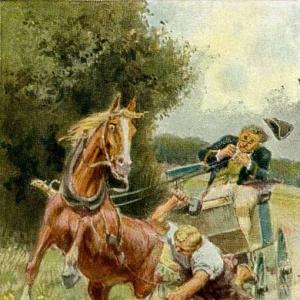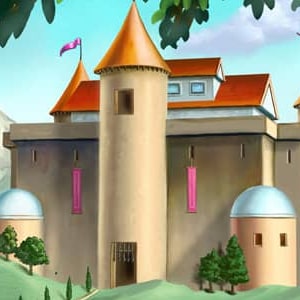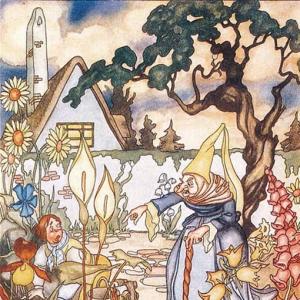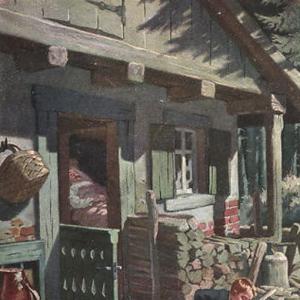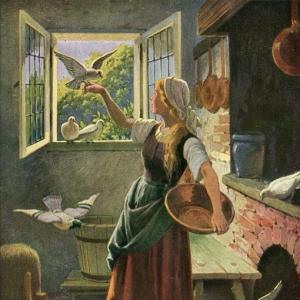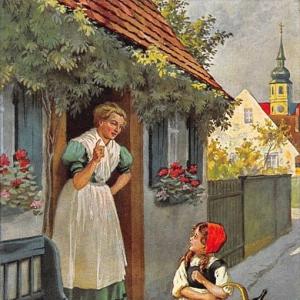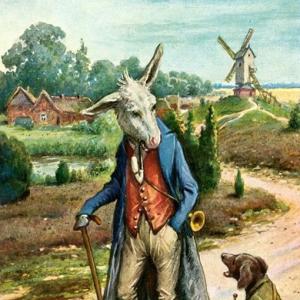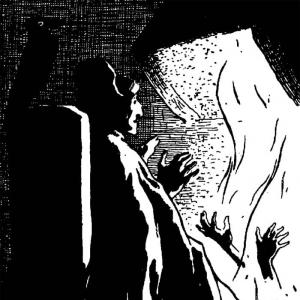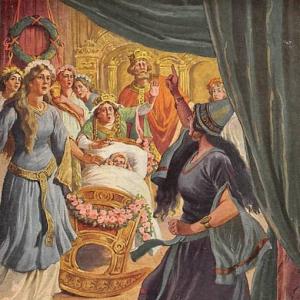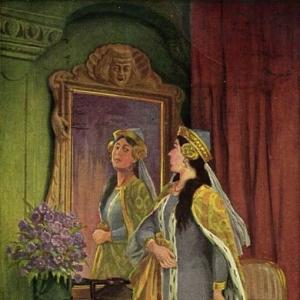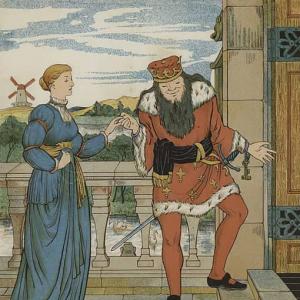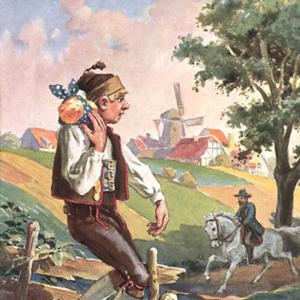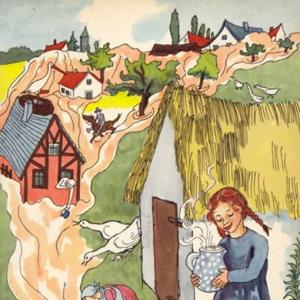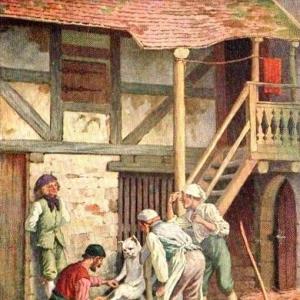Reading time: 16 min
There was once a King’s son, who was no longer content to stay at home in his father’s house, and as he had no fear of anything, he thought, „I will go forth into the wide world, there the time will not seem long to me, and I shall see wonders enough.“ So he took leave of his parents, and went forth, and on and on from morning till night, and whichever way his path led it was the same to him. It came to pass that he got to the house of a giant, and as he was so tired he sat down by the door and rested. And as he let his eyes roam here and there, he saw the giant’s playthings lying in the yard. These were a couple of enormous balls, and nine-pins as tall as a man. After a while he had a fancy to set the nine-pins up and then rolled the balls at them, and screamed and cried out when the nine-pins fell, and had a merry time of it. The giant heard the noise, stretched his head out of the window, and saw a man who was not taller than other men, and yet played with his nine-pins. „Little worm,“ cried he, „why art thou playing with my balls? Who gave thee strength to do it?“ The King’s son looked up, saw the giant, and said, „Oh, thou blockhead, thou thinkest indeed that thou only hast strong arms, I can do everything I want to do.“ The giant came down and watched the bowling with great admiration, and said, „Child of man, if thou art one of that kind, go and bring me an apple of the tree of life.“ – „What dost thou want with it?“ said the King’s son. „I do not want the apple for myself,“ answered the giant, „but I have a betrothed bride who wishes for it. I have travelled far about the world and cannot find the tree.“ – „I will soon find it,“ said the King’s son, „and I do not know what is to prevent me from getting the apple down.“ The giant said, „Thou really believest it to be so easy! The garden in which the tree stands is surrounded by an iron railing, and in front of the railing lie wild beasts, each close to the other, and they keep watch and let no man go in.“ – „They will be sure to let me in,“ said the King’s son. „Yes, but even if thou dost get into the garden, and seest the apple hanging to the tree, it is still not thine; a ring hangs in front of it, through which any one who wants to reach the apple and break it off, must put his hand, and no one has yet had the luck to do it.“ – „That luck will be mine,“ said the King’s son. Then he took leave of the giant, and went forth over mountain and valley, and through plains and forests, until at length he came to the wondrous garden.
The beasts lay round about it, but they had put their heads down and were asleep. Moreover, they did not awake when he went up to them, so he stepped over them, climbed the fence, and got safely into the garden. There, in the very middle of it, stood the tree of life, and the red apples were shining upon the branches. He climbed up the trunk to the top, and as he was about to reach out for an apple, he saw a ring hanging before it; but he thrust his hand through that without any difficulty, and gathered the apple. The ring closed tightly on his arm, and all at once he felt a prodigious strength flowing through his veins. When he had come down again from the tree with the apple, he would not climb over the fence, but grasped the great gate, and had no need to shake it more than once before it sprang open with a loud crash. Then he went out, and the lion which had been lying down before, was awake and sprang after him, not in rage and fierceness, but following him humbly as its master.
The King’s son took the giant the apple he had promised him, and said, „Seest thou, I have brought it without difficulty.“ The giant was glad that his desire had been so soon satisfied, hastened to his bride, and gave her the apple for which she had wished. She was a beautiful and wise maiden, and as she did not see the ring on his arm, she said, „I shall never believe that thou hast brought the apple, until I see the ring on thine arm.“ The giant said, „I have nothing to do but go home and fetch it,“ and thought it would be easy to take away by force from the weak man, what he would not give of his own free will. He therefore demanded the ring from him, but the King’s son refused it. „Where the apple is, the ring must be also,“ said the giant; „if thou wilt not give it of thine own accord, thou must fight with me for it.“
They wrestled with each other for a long time, but the giant could not get the better of the King’s son, who was strengthened by the magical power of the ring. Then the giant thought of a stratagem, and said, „I have got warm with fighting, and so hast thou. We will bathe in the river, and cool ourselves before we begin again.“ The King’s son, who knew nothing of falsehood, went with him to the water, and pulled off with his clothes the ring also from his arm, and sprang into the river. The giant instantly snatched the ring, and ran away with it, but the lion, which had observed the theft, pursued the giant, tore the ring out of his hand, and brought it back to its master. Then the giant placed himself behind an oak-tree, and while the King’s son was busy putting on his clothes again, surprised him, and put both his eyes out.
And now the unhappy King’s son stood there, and was blind and knew not how to help himself. Then the giant came back to him, took him by the hand as if he were someone who wanted to guide him, and led him to the top of a high rock. There he left him standing, and thought, „Just two steps more, and he will fall down and kill himself, and I can take the ring from him.“ But the faithful lion had not deserted its master. It held him fast by the clothes, and drew him gradually back again. When the giant came and wanted to rob the dead man, he saw that his cunning had been in vain. „Is there no way, then, of destroying a weak child of man like that?“ said he angrily to himself, and seized the King’s son and led him back again to the precipice by another way, but the lion which saw his evil design, helped its master out of danger here also. When they had got close to the edge, the giant let the blind man’s hand drop, and was going to leave him behind alone, but the lion pushed the giant so that he was thrown down and fell, dashed to pieces, on the ground.
The faithful animal again drew its master back from the precipice, and guided him to a tree by which flowed a clear brook. The King’s son sat down there, but the lion lay down, and sprinkled the water in his face with its paws. Scarcely had a couple of drops wetted the sockets of his eyes, than he was once more able to see something, and remarked a little bird flying quite close by, which wounded itself against the trunk of a tree. On this it went down to the water and bathed itself therein, and then it soared upwards and swept between the trees without touching them, as if it had recovered its sight again. Then the King’s son recognized a sign from God and stooped down to the water, and washed and bathed his face in it. And when he arose he had his eyes once more, brighter and clearer than they had ever been.
The King’s son thanked God for his great mercy, and travelled with his lion onwards through the world. And it came to pass that he arrived before a castle which was enchanted. In the gateway stood a maiden of beautiful form and fine face, but she was quite black. She spoke to him and said, „Ah, if thou couldst but deliver me from the evil spell which is thrown over me.“ – „What shall I do?“ said the King’s son. The maiden answered, „Thou must pass three nights in the great hall of this enchanted castle, but thou must let no fear enter thy heart. When they are doing their worst to torment thee, if thou bearest it without letting a sound escape thee, I shall be free. Thy life they dare not take.“ Then said the King’s son, „I have no fear; with God’s help I will try it.“ So he went gaily into the castle, and when it grew dark he seated himself in the large hall and waited. Everything was quiet, however, till midnight, when all at once a great tumult began, and out of every hole and corner came little devils. They behaved as if they did not see him, seated themselves in the middle of the room, lighted a fire, and began to gamble. When one of them lost, he said, „It is not right. Some one is here who does not belong to us. It is his fault that I am losing.“ – „Wait, you fellow behind the stove, I am coming,“ said another. The screaming became still louder, so that no one could have heard it without terror. The King’s son stayed sitting quite quietly, and was not afraid; but at last the devils jumped up from the ground, and fell on him, and there were so many of them that he could not defend himself from them. They dragged him about on the floor, pinched him, pricked him, beat him, and tormented him, but no sound escaped from him. Towards morning they disappeared, and he was so exhausted that he could scarcely move his limbs, but when day dawned the black maiden came to him. She bore in her hand a little bottle wherein was the water of life wherewith she washed him, and he at once felt all pain depart and new strength flow through his veins. She said, „Thou hast held out successfully for one night, but two more lie before thee.“ Then she went away again, and as she was going, he observed that her feet had become white. The next night the devils came and began their gambols anew. They fell on the King’s son, and beat him much more severely than the night before, until his body was covered with wounds. But as he bore all quietly, they were forced to leave him, and when dawn appeared, the maiden came and healed him with the water of life. And when she went away, he saw with joy that she had already become white to the tips of her fingers. And now he had only one night more to go through, but it was the worst. The hob-goblins came again: „Art thou there still?“ cried they, „thou shalt be tormented till thy breath stops.“ They pricked him and beat him, and threw him here and there, and pulled him by the arms and legs as if they wanted to tear him to pieces, but he bore everything, and never uttered a cry. At last the devils vanished, but he lay fainting there, and did not stir, nor could he raise his eyes to look at the maiden who came in, and sprinkled and bathed him with the water of life. But suddenly he was freed from all pain, and felt fresh and healthy as if he had awakened from sleep, and when he opened his eyes he saw the maiden standing by him, snow-white, and fair as day. „Rise,“ said she, „and swing thy sword three times over the stairs, and then all will be delivered.“ And when he had done that, the whole castle was released from enchantment, and the maiden was a rich King’s daughter. The servants came and said that the table was already set in the great hall, and dinner served up. Then they sat down and ate and drank together, and in the evening the wedding was solemnized with great rejoicings.
 Learn languages. Double-tap on a word.Learn languages in context with Childstories.org and Deepl.com.
Learn languages. Double-tap on a word.Learn languages in context with Childstories.org and Deepl.com.Backgrounds
Interpretations
Adaptions
Summary
Linguistics
„The King’s Son Who Feared Nothing“ is a German fairy tale collected by the Brothers Grimm, who were linguists, cultural researchers, and authors known for their collection of folk tales. The Brothers Grimm, Jacob and Wilhelm, first published their collection of stories, „Children’s and Household Tales,“ in 1812, and this collection eventually became known as „Grimms‘ Fairy Tales.“ These stories have been translated into more than 100 languages and are considered an essential part of the Western literary canon.
The Brothers Grimm collected their stories from various sources, including oral traditions, written manuscripts, and from people they knew personally. Their aim was to preserve the cultural heritage of Germanic folklore, which they believed was at risk of being lost due to the modernization and urbanization of the time. The tales often contained moral lessons and reflected the values and beliefs of the Germanic people.
„The King’s Son Who Feared Nothing“ is a lesser-known tale in the Grimms‘ collection, but it shares some common elements with other fairy tales, such as quests, magical objects, and enchanted beings. The story follows a courageous prince who embarks on a journey to prove his strength and fearlessness. Along the way, he encounters a giant, wild beasts, and an enchanted maiden, all of which he must overcome to achieve his goal.
As with many other fairy tales, „The King’s Son Who Feared Nothing“ incorporates themes of bravery, perseverance, love, and personal growth. These themes are explored through the protagonist’s challenges and the transformative power of love and compassion. The story also reflects the importance of faith and divine guidance, as the prince relies on his belief in God to help him navigate his journey.
„The King’s Son Who Feared Nothing“ is a tale rich with symbolism and themes that can be interpreted in various ways. Some possible interpretations include.
The importance of courage and perseverance: The prince’s fearlessness and determination to complete the tasks set before him, despite the dangers and challenges he faces, are crucial to his success. This story encourages readers to face their fears and not give up in the face of adversity.
The transformative power of love and compassion: The prince’s kindness and willingness to help the black maiden break her curse ultimately lead to their love and marriage. The healing power of the water of life, which is used by the maiden to heal the prince’s wounds, further highlights the theme of love and its ability to heal and transform.
The battle between good and evil: The prince’s confrontations with the giant and the devils symbolize the struggle between good and evil. The prince’s triumph over these malevolent forces shows that good can prevail when one remains true to their values and perseveres through difficult times.
The role of faith and divine guidance: Throughout the story, the prince relies on his faith in God to guide and protect him. This faith is rewarded with divine intervention, such as the healing waters that restore his sight and the lion that defends him against the giant. This theme encourages readers to trust in a higher power for guidance and protection in their own lives.
Personal growth and self-discovery: The prince’s journey is not only an external adventure but also an internal quest for self-discovery and growth. He overcomes various obstacles and learns about his own strength and capabilities along the way. In the end, he emerges as a wiser and more capable individual, ready to face the world with newfound confidence.
These interpretations offer just a few ways to understand „The King’s Son Who Feared Nothing.“ The tale can be seen as a timeless story of courage, love, and personal growth, offering valuable life lessons for readers of all ages.
„The King’s Son Who Feared Nothing“ has inspired various adaptations and retellings over the years. Here are a few notable examples.
„The Brave Little Tailor“ (also known as „The Valiant Little Tailor“) is a fairy tale collected by the Brothers Grimm that shares similarities with „The King’s Son Who Feared Nothing.“ In this story, a tailor tricks a group of giants into believing he is strong and brave and earns the respect of the king.
The 2010 film „Tangled“ (Disney) draws inspiration from several fairy tales, including „The King’s Son Who Feared Nothing.“ The protagonist, Rapunzel, is kidnapped and held captive by a wicked witch until a prince comes to rescue her.
The 2012 film „Jack the Giant Slayer“ features a young farmhand who must rescue a princess from a race of giants. The film incorporates elements of „The King’s Son Who Feared Nothing,“ as well as other fairy tales.
In the novel „The Fairy Godmother“ by Mercedes Lackey, the protagonist, Elena Klovis, is a descendant of the prince in „The King’s Son Who Feared Nothing.“ She must follow in his footsteps and overcome various obstacles in order to fulfill her destiny.
In the television series „Once Upon a Time,“ the character Prince Charming is based on the hero of „The King’s Son Who Feared Nothing.“ Like the prince in the fairy tale, Prince Charming is brave and daring, and he must overcome numerous obstacles to win the heart of his true love.
Overall, „The King’s Son Who Feared Nothing“ has proven to be a popular and enduring fairy tale, inspiring countless adaptations and retellings in various forms of media.
„The King’s Son Who Feared Nothing“ is a fairy tale by the Brothers Grimm about a fearless and adventurous young prince who leaves his home to explore the world. Along the way, he encounters a giant and his giant-sized nine-pins and balls. The giant, impressed by the prince’s strength, sends him on a quest to fetch an apple from the Tree of Life for his betrothed.
The prince successfully retrieves the apple, and in doing so, gains a magical ring that grants him immense strength. A battle ensues between the prince and the giant over the ring, but the prince’s faithful lion protects him and ultimately kills the giant. The prince loses his eyesight in the process, but eventually regains it after following the guidance of a small bird and bathing his eyes in a healing brook.
Continuing his journey, the prince comes across an enchanted castle with a beautiful but cursed black maiden who seeks his help to break the spell. He must endure three nights of torment by a horde of devils without making a sound. Each night, the black maiden heals his wounds with the water of life and gradually turns white, signifying the weakening of the enchantment.
After successfully enduring the three nights, the prince breaks the spell by swinging his sword over the castle stairs, and the black maiden is revealed to be a rich King’s daughter. They celebrate their victory with a feast and eventually get married, marking the end of the tale with joy and happiness.
The fairy tale „The King’s Son Who Feared Nothing“ by the Brothers Grimm presents a rich tapestry of themes, motifs, and linguistic elements characteristic of traditional folklore.
Here’s a linguistic analysis of the tale:
Themes and Motifs
Fearlessness and Bravery: The protagonist’s defining trait is his lack of fear, which propels the narrative. This theme is common in fairy tales, where characters often possess a single, exaggerated trait that aids them in their quest.
Quest and Adventure: The story follows a quest narrative, with the King’s son embarking on a journey to find the tree of life. This motif of a journey or quest is a staple in fairy tales, symbolizing personal growth and the acquisition of wisdom.
Magic and Enchantment: The tale features magical elements, such as the tree of life, the ring of power, and the enchanted castle, which are typical of the genre. These supernatural elements create a sense of wonder and possibility.
Good vs. Evil: The narrative pits the brave King’s son and his loyal lion against the deceptive giant and mischievous devils, highlighting the timeless conflict between good and evil.
Transformation and Redemption: The tale concludes with transformation, particularly of the black maiden who turns white, symbolizing purification and the lifting of enchantment.
Dialogue: The story includes direct dialogue, which serves to develop characters and advance the plot. The conversations often contain archaic language and formal structures, reflective of the tale’s historical and cultural context (e. g. , „Little worm,“ „Thou art there still?“).
Formulaic Expressions: Phrases like „It came to pass“ and „And it came to pass that he arrived“ are typical of oral storytelling, providing rhythmic and mnemonic support for storytellers.
Narrative Structure: The story follows a linear narrative with a clear beginning, middle, and end, characteristic of oral tradition. There are episodic elements, with distinct challenges (the quest for the apple, the wrestling with the giant, the nights in the castle) building towards the climax.
Repetition: Repetition is used for emphasis and to aid memory, especially in the trials the King’s son faces each night, which become increasingly challenging.
Symbolism: The story is rich in symbols—the apple represents life and knowledge; the ring symbolizes power and strength; the lion embodies loyalty and protection; and the transformation of the maiden signifies rebirth and purification.
Cultural and Historical Context
The linguistic style of the fairy tale reflects the Brothers Grimm’s efforts to preserve the oral storytelling tradition of the Germanic cultures. They often used archaic language and thematic elements common in European folklore to imbue their tales with a timeless quality, resonating with moral and ethical undertones.
Moral and Ethical Implications
The narrative suggests several moral lessons:
Courage and Perseverance: The King’s son’s unwavering bravery and persistence through trials ultimately lead to success and reward.
Loyalty and Friendship: The loyalty of the lion highlights the importance of companionship and support in overcoming adversities.
Justice and Retribution: The giant’s deceptive actions lead to his downfall, implying that evil actions are eventually punished.
In summary, „The King’s Son Who Feared Nothing“ is a classic Grimm fairy tale, utilizing linguistic features typical of oral tradition to convey themes of bravery, friendship, and the triumph of good over evil. Its structure, motifs, and moral lessons reflect the cultural heritage of the time and continue to resonate with audiences today.
Information for scientific analysis
Fairy tale statistics | Value |
|---|---|
| Number | KHM 121 |
| Aarne-Thompson-Uther-Index | ATU Typ 590 |
| Translations | DE, EN, DA, ES, PT, IT, JA, NL, PL, RU, TR, VI, ZH |
| Readability Index by Björnsson | 32 |
| Flesch-Reading-Ease Index | 80.3 |
| Flesch–Kincaid Grade-Level | 7.7 |
| Gunning Fog Index | 10.4 |
| Coleman–Liau Index | 7.3 |
| SMOG Index | 8.2 |
| Automated Readability Index | 8.5 |
| Character Count | 10.980 |
| Letter Count | 8.413 |
| Sentence Count | 94 |
| Word Count | 2.145 |
| Average Words per Sentence | 22,82 |
| Words with more than 6 letters | 198 |
| Percentage of long words | 9.2% |
| Number of Syllables | 2.620 |
| Average Syllables per Word | 1,22 |
| Words with three Syllables | 69 |
| Percentage Words with three Syllables | 3.2% |

 Facebook
Facebook  Whatsapp
Whatsapp  Messenger
Messenger  Telegram
Telegram Reddit
Reddit